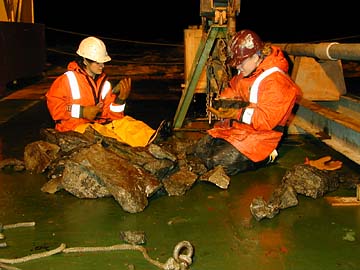
Dredging the sea floor

Shown here are Sarah Lichtentstein (left) and Courtney Zimmer examining geologic samples brought up from the bottom of the Weddell Sea 900 meters below. Sarah, a geology major, is working with Dr. Eugene Domack on the chronology of encrusting organisms on the Antarctic sea floor. Courtney, a graduating senior biology major, worked with Dr. Patrick Reynolds on benthic life forms in the waters surrounding Antarctica.
Good morning from the Weddell Sea. Current position 64 46 south, 60 29 west.
4 am, a beautiful full moon lights up the landscape and the request for warmer weather was granted. It is currently almost 40 degrees with a light wind.
We are starting to do intense sampling of the sub sea basin we mapped yesterday. The bottom seems to alternate between very rocky and that which is more sediment covered. Our first two coring attempts brought up short cores with a mix of sediment and rocks. We then dragged the bottom with a dredge which is designed to collect rocks off the bottom and came up with a large collection, many of which have small animals growing on them.
Following the dredging operation we moved to a new site and will again attempt to core this area. At our current position we are running a CTD study which measures conductivity (which is related to salinity), temperature and depth. This information is sent up a wire to a computer on the ship and gives real time information on the changes in the water column with depth. This instrument is attached to an array of sampling bottles that can be triggered remotely to sample the water at specific depths. These bottles have spring loaded caps that are held open as the instrument is lowered into the water. Once on the bottom the bottle array is brought back towards the surface. At points where the water chemists want samples a signal is sent to the array and a specific bottle's caps close capturing the water at that depth. This routine is repeated all the way to the surface so once the array is brought back on board the bottles contain uncontaminated water samples from various depths throughout the water column.
With the CTD back on board the next sampling or coring operation can begin. Only one instrument is put over the side at a time so multiple sampling methods can take many hours. With 900-1000 meters of cable out the chances of tangling cables is too great to put out more than one instrument at a time. The ship maintains it's position over a sampling site using it's bow and stern thrusters and the GPS navigation system.
Much more to come, hope all are enjoying the trip. We certainly are!
Dave Tewksbury
tewksbda@nbp.polar.org
<<May 16 pm * May 17pm>>